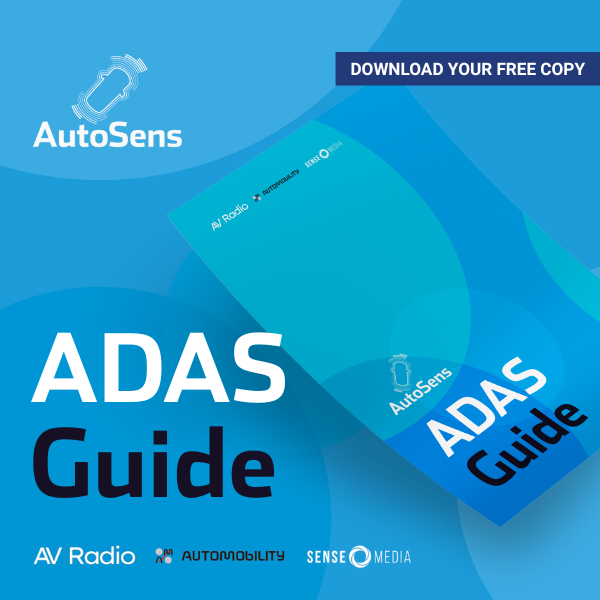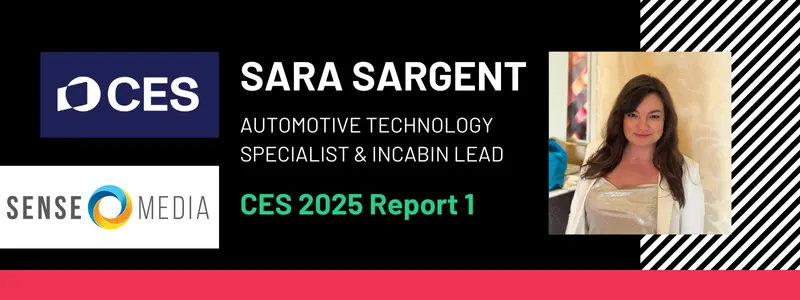
During CES I met with companies focused on technology for both the exterior perception stack and interior sensing and experience. I had a different strategy this year so I could report in more detail and with more context. I met with fewer companies for better in-depth conversations to find out more about exactly how they fit into the market, the background of their leadership team, their business strategy, and why they’re building the solutions they are. These reports will cover conversations with both Suppliers and T1s.
There will be at least 3 reports in this series, this first one is going to cover a variety of both interior and exterior, then I’ll do one report each on interior and one on exterior. There were a few companies I spent 2-3 hours with so if I have time I’ll do deeper dives on them. This first report in particular will cover a wide range of solutions:
Bosch – Upskilling for Gen AI
SDVerse – Community marketplace for SW suppliers
Elektrobit – Easy to use platform for designing custom UI
Aptiv – Supply chain digital twin
TomTom – HD Maps for driver safety and convenience applications
Ambarella – VLMs to inform drivers and improve system utilization
Tweddle – Helping OEMs ensure consumers understand their diagnostics and ADAS
Audio Foundry – Companies working together to provide audio safety and wellness applications
MAKING ENGINEERS’ JOBS EASIER
First, I have great news for our engineering audience, which is that there was a massive trend towards tools that help make engineers’ jobs easier. I’ve been meeting with more and more companies in the last year who are mentioning these tools so I was very glad to see this trend growing in the industry. Many companies explained that they’re providing SDKs that are able to make the early stage development go more quickly. With the pressure from the Chinese market, time to market is more important to companies who are competing there.
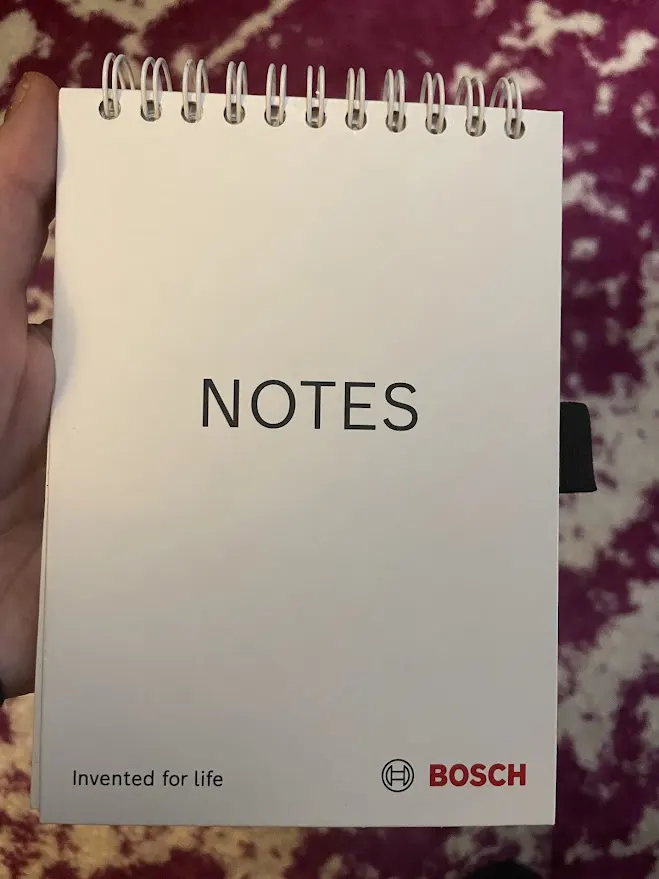
1. Bosch has launched the AI Academy internally for their associates. As the role of generative AI grows, so does the demand for upskilling those who can improve their work by using it. 65k Bosch associates have participated in this training. Bosch says that AI should support, not replace and this is a smart method for living up to that. Bosch has 1500 AI patents in the last 5 years, the most for one company in Europe. This fits with their tagline “coded #likeaBosch”. They talked about their collaboration with VW and Cariad on a collaborative, hardware agnostic, open platform for SDV development. Thanks to Bosch for the perfectly sized notebook at the press announcement – it fit well in my purse and I ended up using it for all of CES! Only a couple empty pages left!
2. For those who need automotive software there’s a new company in town who is offering a community to make this shopping experience much easier. SDVerse was started a few years ago in stealth mode and operates with a leadership team who have extensive experience in automotive & tech – Ford, Bosch, FCA, ZF, Faraday… They have come out of stealth in September of 2024. Since they have ex-OEMs on the leadership team they know what OEMs prioritize when they are evaluating technologies – enabling the seller companies to be prepared with the right information, including documents and even videos. The buyer can do a product comparison, where they can input what they want and the system will automatically pull up the relevant information.
Companies who are involved can be sellers and buyers. Sellers list their SW products in the platform with 180 different attributes. They upload documents with details, and you can directly message them in the platform to ask questions. I met with Pavan Vemuri, Director of Product Engineering, who is very passionate about how they’re using AI to make the shopping experience more robust for both parties. I was impressed with how well thought out the platform is for the buyers. OEMs can post RFQs and control who is able to see the RFQs. They can collect them in a matter of days and weeks, a massive time savings on a process that more typically takes 5-6 months. Some of their members already include Magna, GM, Bosch, Renault, FORVIA, and Valeo…
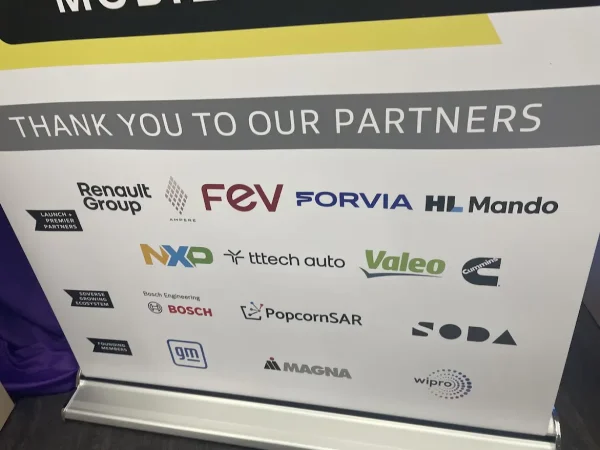
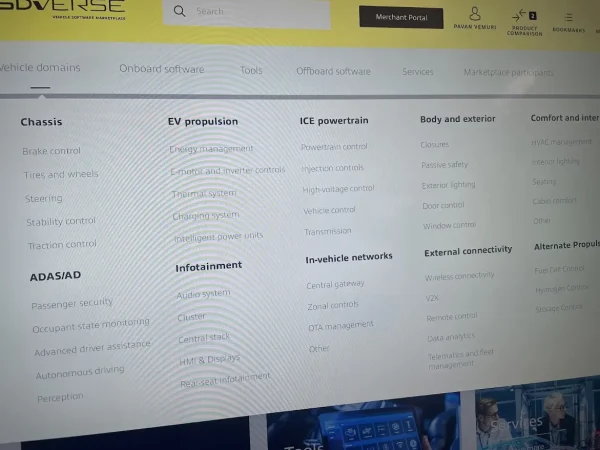
3. Elektrobit is working with Figma for designers to use their theming engine, which allows for much faster design iteration. The platform takes your specific OEM design elements like font, icon, color schemes, and applies them. You can use the theme engine + AI to prompt it and ask for things like “Tokyo inspired theme” that meet the brand requirements of the OEM. When the designer is happy they can test the themes immediately on the emulator and then have it updated via OTA and through the App Store.
Elektrobit have been around for over 35 years, owned by Continental but working with all T1s. They innovate directly with the OEMs and are open to new working models. They have an SDV approach to help OEMs understand where to start, providing architecture support and work end to end and direct to SOP.
Because of their approach they are finding that new OEMs really like working with them, including Sony and Honda’s AFEELA. They are working in China, which tends to be more interested in experimenting, allowing Elektrobit to learn more which they can then introduce to other markets. As a result they are working with more traditional OEMs helping them to leap-frog to catch up to their more innovative competitors.
I asked Dr. Siegfried Dirr, VP and Head of Engineering Services & Technologies, what he liked about working for Elektrobit and he said that he likes how they can connect with customers because they always have something real they can showcase, something that is surely impactful for companies in this space.
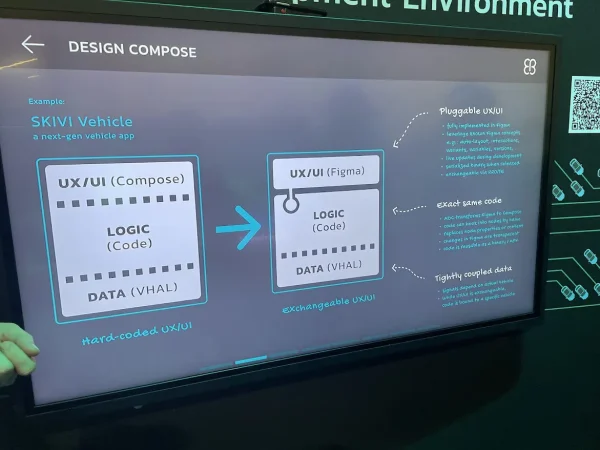
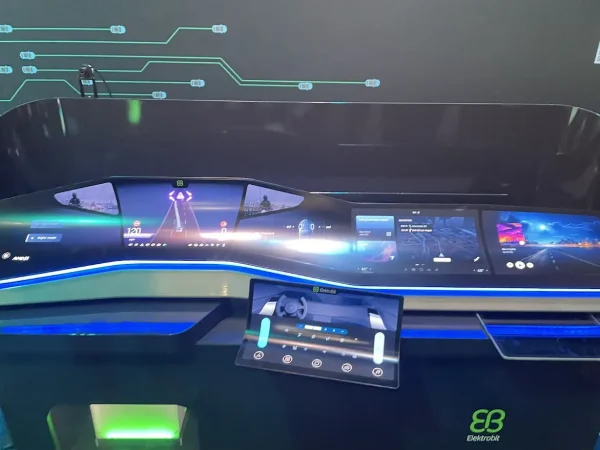
4. Aptiv is leveraging a Supply Chain Digital Twin which helps everyone from design to procurement make well informed decisions about the components that are required for their devices, particularly with regard to global supply chain risk. I asked what the difference was that made this a digital twin rather than a chart. They explained to me how they can pull data from each part of the supply chain based on region, timing, company, and make well informed decisions based on weather or relevant geo-political events. This gives the engineering teams so much more confidence when they are making design decisions. As an engineer who was on the wrong side of an image sensor that went EOL, and doing HW refits during the chip crisis in 2020, I could instantly see the value of this for several parts of their business. (I have way more to write about Aptiv in following reports).
BRINGING TOGETHER EXTERNAL PERCEPTION AND DRIVER SAFETY
This is something we’ve been seeing more and more over the last year. At InCabin and AutoSens we had Novelic, who began with a focus on in-cabin sensing and are now providing both internal and external solutions. We have Novus Hi-Tech who started with automated driving, now moving in-cabin to sync the driver with their external system. There was a recurring theme of helping the driver feel more comfortable with the technology, often just by communicating what they’re doing and their intention with the driver via audio or visuals.
We carried on this unification for our AutoSens and InCabin Communities at CES with a super fun, casual meetup on Monday night! Great to see everyone and we will certainly arrange this again next year.
5. TomTom changed my impression of the role of maps for the in-cabin user experience. I have a history of working on advanced prototype HD mapping applications with HERE when I was at VSI Labs. The applications were for things like lane keeping and speed control, that was about 4 years ago. Now I can see how much can be done with this map data inside the vehicle. A lot of tech and time go into keeping these maps up to date and frankly I think now is the time that consumers should be benefiting from it, as well as the system designers.
TomTom has 600M devices connected globally to crowd source not just the map data, but the driving data, the way the car moves on the roadway. They call these “behavioral maps” and it turns out they are super useful. They can see where at a stop sign drivers start braking, where there are frequent hard braking incidents, and use that to inform both human and AV drivers of risk. The sourced traffic data with positioning can be used to train the model to make the automated driver feel more natural. Some in-cabin applications:
- AV Geofencing would allow drivers to choose their route based on factors like having the most hands-free time instead of the shortest time.
- There are 3-4 types of driving personas based on the behavioral maps, and users could choose a geo-based driving persona.
- Because of real time data your companion app is informed of traffic jams, and you could have it proactively send alerts to your phone when it knows you would need to leave early for work.
- If a charger you usually use at your office is down, the companion app could give you alternate charging options.
- The system can give indicators of the PED crossings and bike lanes to the driver before the vision system, informing the driver that the route will cross over a PED or bike lane.
I’m very happy to see HD mapping joining the conversation at InCabin, there is so much that can be done with all this data to make the systems more robust and more useful overall for both drivers and VRUs.
6. Ambarella took me on a clever driving demo that told me what the car was doing. The demo ran on the CV3 as an L2+ system with 6 cameras. They are using Video Language Models to train on external perception data to assess what is happening in the situation. The system told the driver what it detects and why it needs to slow down or change lanes for instance. As we were driving but stopped at a light, the car told me that the car in front of us was waiting so we were waiting. Later we pulled into a valet drop off behind a parked vehicle. The car told me that this vehicle was parked and we needed to go around it.
Their Smart Vehicle Security system uses the external cameras to turn on if there is someone near the car, the VLM trained system can identify if the person near the car is a threat, what they are holding, and alert the vehicle’s owner by saying something with detail “someone is hitting your car with an umbrella”.
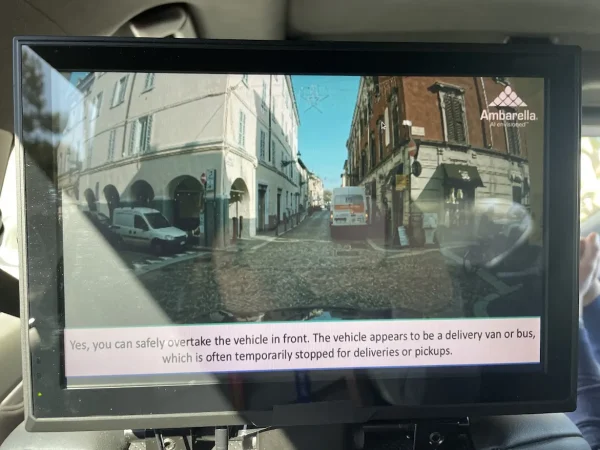
I asked Eric and his team why I would choose to work with Ambarella over NVIDIA. They had some impressive test metrics showing their CV3 performance against NVIDIA and it performed as well and better at 1/3 the power cost. When I pressed they said they can do this over their competitors because they are purpose designing specifically for these automotive applications.
Ambarella also showed some notable partnerships and wins across automotive. They are working with Seeing Machines Guardian, with Aptiv on the Smart Car for L2+ with 5 cameras and 5 radar. They are in production with LG for DMS, and with Quanta Computing on an aftermarket fleet device using telematics, providing security, ADAS and DMS. I think I may have asked the toughest questions of Ambarella, and I was very satisfied with the answers they gave. As a relatively small team compared to their large competitors, they are very sharp and nimble.
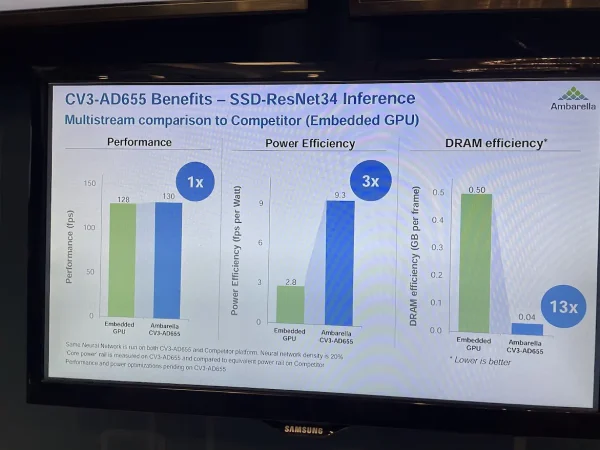
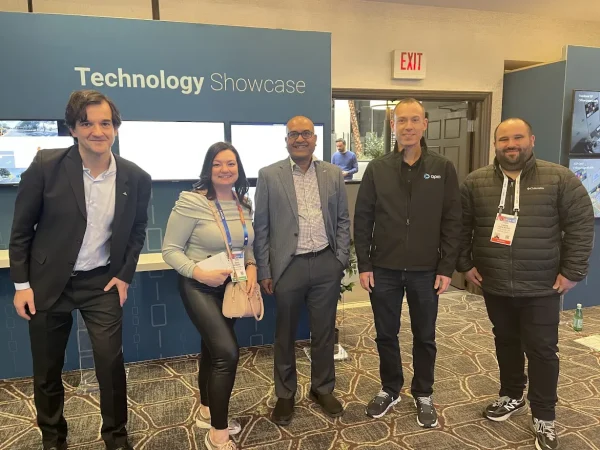
7. Tweddle was a new company for me, and to understand them best you have to appreciate their background, working directly with the OEMs to create their owners’ manuals for over 50 years. They have been at the forefront of how the OEMs communicate with their consumers. This is really important now that we’re outfitting cars with critical sensor systems that are becoming more regulated and less accessible/understandable to consumers who might be used to fixing their own cars.
When Melissa and I were at the Paris Motor Show, one of our favorite new applications was seeing that SKODA had a really clear animated tutorial for each ADAS feature, teaching the driver what it would do and when it was ok to use. These folks make those, but way more capable.
For instance, they will integrate with the system to actually tell the driver what their indicator light means, how critical the indicated issue is, and offer to diagnose it with them. If I was diagnosing why my ACC wasn’t working, the system might tell me to go clear off the front of my bumper, then I can tell it I’ve done that and it will test the radar for me then, rather than waiting for me to be on the road. If it’s not fixed it could tell me the criticality and offer to make an appointment at the shop for it to be fixed. They call this assistant AVA. This is brilliant and something we’re talking about introducing to our agenda for AutoSens and InCabin USA this June.
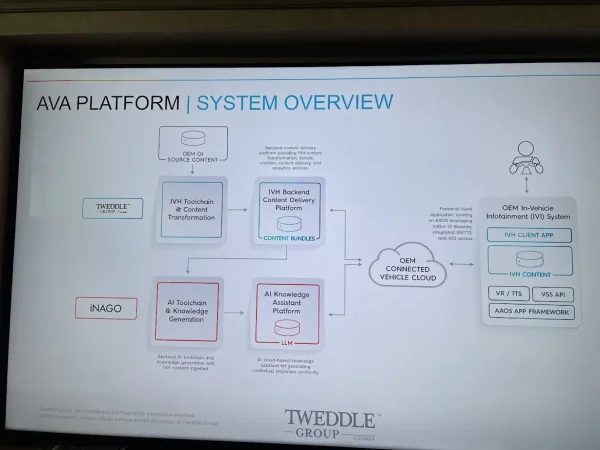
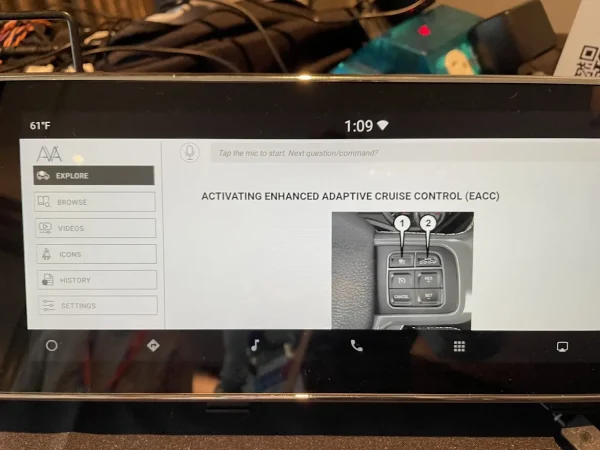
They also talked about the ability for OEMs to use this to roll out and trace recalls – something really valuable and costly when traceability is difficult by mail or email.
Here is their CES press release if you want to read more.
8. Audio Foundry is a group of members who work together on providing audio solutions directly to the OEMs. Their members include a wide array of expertise from OEM to market research to the suppliers themselves. For the L2 – L3+ automotive industry they provide solutions from a partnership made of Dirac, Denon, Tymphany, and Sonified – who offer a combined 22 devices to work with.
I asked Tony Harberman and his team about how audio intertwines with safety:
- They are able to move some elements from the signal processor to the CPU to free up the DSP for time critical applications (road noise cancellation for instance).
- They can provide external sound for VRUs.
- They can produce an external sonic signature for collision avoidance.
- They can use an external mic to detect sirens and where they’re coming from which can then be used to provide the direction of the sirens to the driver.
Audio Foundry Sound demo
My favorite part was easily when I sat in the demo car and listened to the difference of their stereo vs. immersive sound. In the chaos that is CES, 5 minutes of sound bathing (listening to music) felt like the ultimate relaxation and was surprisingly restorative. This sounds inconsequential but it’s not. Our industry is rightfully spending a ton of time and resource to understand if that driver is stressed because of how dangerous it is. CES had tons of non-auto tech to reduce stress and anxiety. Using audio to mitigate that stress is a very real and viable solution and the time is right for the OEMs to start incorporating it into their wellness and safety systems.
I’m excited to have more audio companies involved in InCabin and AutoSens this year, they can provide really important elements of the drivers’ safety and comfort experiences…and they make for excellent demos, which if you know me or InCabin – is really important to us.
Do you think your technology deserves to be showcased at AutoSens or InCabin?
The next event takes place this June in Detroit, and we’re inviting applications to speak. To be considered, submit a 500-word abstract by January 24th.
This is an excellent opportunity to highlight your technical expertise while educating and engaging automotive engineers. There’s no cost to apply or present—just ensure your submission is technically informative and relevant to senior engineers from OEMs, Tier 1 suppliers, and other key stakeholders.
All submissions will be reviewed by the Advisory Boards for InCabin and AutoSens, with selections made based on technical merit. Don’t miss the chance to contribute and shine on this influential stage!


